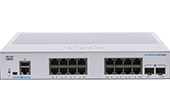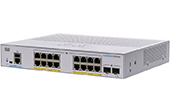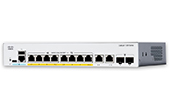12-port 10G Copper + 12-port 10G SFP+ Managed Switch CISCO CBS350-24XTS-EU
Trang Chủ >>
Thiết bị mạng >> Thiết bị mạng Cisco >> 12-port 10G Copper + 12-port 10G SFP+ Managed Switch CISCO CBS350-24XTS-EU


Mã số:04210522

12-port 10G Copper + 12-port 10G SFP+ Managed Switch CISCO CBS350-24XTS-EU
- Support 12 x 10 Gigabit copper ports; 12 x 10 Gigabit SFP+ (dedicated); 1 x GE management port; Rack-mountable.
- Console port: Cisco standard RJ45 console port.
- USB slot: USB Type-A slot on the front panel of the switch for easy file and image management.
- Flash: 800MHz ARM.
- DRAM: 512MB.
- Packet buffer: 3MB.
- Dimensions (W x D x H): 440 x 350 x 44 mm.
- Weight: 4.84kg.
Đặc tính kỹ thuật
| Performance | |
| Switching capacity and forwarding rate All switches are wire speed and nonblocking |
- Capacity in Millions of Packets per Second (mpps) (64-byte packets): 240mpps - Switching Capacity in Gigabits per Second (Gbps): 480mpps |
| Hardware | |
| Power consumption (worst case) | System Power Consumption: + 110V=78.4W + 220V=80.2W Heat Dissipation (BTU/hr): 273.65 |
| Ports | Total System Ports: 12 x 10G copper + 12 x 10G SFP+ + 1 x GE OOB management |
| RJ-45 Ports: 12 x 10G copper | |
| Combo Ports (RJ45 + Small form-factor pluggable [SFP]): 12 x 10G SFP+ | |
| Console port | Cisco standard RJ45 console port |
| USB slot | USB Type-A slot on the front panel of the switch for easy file and image management |
| Buttons | Reset button |
| Cabling type | Unshielded Twisted Pair (UTP) Category 5e or better for 1000BASE-T |
| LEDs | System, Link/Act, PoE, Speed |
| Flash | 256 MB |
| CPU | 800 MHz ARM |
| DRAM | 512 MB |
| Packet buffer | 3 MB |
| Environmental | |
| Unit dimensions (W x D x H) | 440 x 350 x 44 mm |
| Unit weight | 4.84 kg |
| Power | 100-240V 50-60 Hz, internal, universal |
| Certification | UL (UL 62368), CSA (CSA 22.2), CE mark, FCC Part 15 (CFR 47) Class A |
| Operating temperature | 32° to 122°F (0° to 50°C) |
| Storage temperature | -13° to 158°F (-25° to 70°C) |
| Operating humidity | 10% to 90%, relative, noncondensing |
| Storage humidity | 10% to 90%, relative, noncondensing |
| Acoustic noise and Mean Time Between Failure (MTBF) | FAN (Number): 3 Acoustic Noise: 25°C: 43.3dB MTBF at 25°C (hours): 1,372,246 |
| Layer 2 Switching | |
| Spanning Tree Protocol | Standard 802.1d Spanning Tree support Fast convergence using 802.1w (Rapid Spanning Tree [RSTP]), enabled by default Multiple Spanning Tree instances using 802.1s (MSTP); 8 instances are supported Per-VLAN Spanning Tree Plus (PVST+) and Rapid PVST+ (RPVST+); 126 instances are supported |
| Port grouping/link aggregation | Support for IEEE 802.3ad Link Aggregation Control Protocol (LACP) - Up to 8 groups - Up to 8 ports per group with 16 candidate ports for each (dynamic) 802.3ad link aggregation |
| VLAN | Support for up to 4,094 VLANs simultaneously Port-based and 802.1Q tag-based VLANs; MAC-based VLAN; protocol-based VLAN; IP subnet-based VLAN Management VLAN Private VLAN with promiscuous, isolated, and community port Private VLAN Edge (PVE), also known as protected ports, with multiple uplinks Guest VLAN, unauthenticated VLAN Dynamic VLAN assignment via RADIUS server along with 802.1x client authentication CPE VLAN |
| Voice VLAN | Voice traffic is automatically assigned to a voice-specific VLAN and treated with appropriate levels of QoS. Voice Services Discovery Protocol (VSDP) delivers network wide zero-touch deployment of voice endpoints and call control devices |
| Multicast TV VLAN | Multicast TV VLAN allows the single multicast VLAN to be shared in the network while subscribers remain in separate VLANs. This feature is also known as Multicast VLAN Registration (MVR) |
| VLAN Translation | Support for VLAN One-to-One Mapping. In VLAN One-to-One Mapping, on an edge interface customer VLANs (C-VLANs) are mapped to service provider VLANs (S-VLANs) and the original C-VLAN tags are replaced by the specified S-VLAN |
| Q-in-Q | VLANs transparently cross a service provider network while isolating traffic among customers |
| Selective Q-in-Q | Selective Q-in-Q is an enhancement to the basic Q-in-Q feature and provides, per edge interface, multiple mappings of different C-VLANs to separate S-VLANs Selective Q-in-Q also allows configuring of Ethertype (Tag Protocol Identifier [TPID]) of the S-VLAN tag Layer 2 protocol tunneling over Q-in-Q is also supported |
| Generic VLAN Registration Protocol (GVRP)/Generic Attribute Registration Protocol (GARP) | Generic VLAN Registration Protocol (GVRP) and Generic Attribute Registration Protocol (GARP) enable automatic propagation and configuration of VLANs in a bridged domain |
| Unidirectional Link Detection (UDLD) | UDLD monitors physical connection to detect unidirectional links caused by incorrect wiring or cable/port faults to prevent forwarding loops and black holing of traffic in switched networks |
| Dynamic Host Configuration Protocol (DHCP) Relay at Layer 2 | Relay of DHCP traffic to DHCP server in different VLAN; works with DHCP Option 82 |
| Internet Group Management Protocol (IGMP) versions 1, 2, and 3 snooping | IGMP limits bandwidth-intensive multicast traffic to only the requesters; supports 2K multicast groups (source-specific multicasting is also supported) |
| IGMP Querier | IGMP querier is used to support a Layer 2 multicast domain of snooping switches in the absence of a multicast router |
| IGMP proxy | The IGMP proxy provides a mechanism for multicast forwarding based on IGMP membership information without the need for more complicated multicast routing protocols. |
| Head-of-Line (HOL) blocking | HOL blocking prevention |
| Loopback Detection | Loopback detection provides protection against loops by transmitting loop protocol packets out of ports on which loop protection has been enabled. It operates independently of STP |
| Layer 3 | |
| IPv4 routing | Wirespeed routing of IPv4 packets Up to 990 static routes and up to 128 IP interfaces |
| IPv6 routing | Wirespeed routing of IPv6 packets |
| Layer 3 Interface | Configuration of Layer 3 interface on physical port, Link Aggregation (LAG), VLAN interface, or loopback interface |
| Classless Interdomain Routing (CIDR) | Support for classless interdomain routing |
| RIP v2 | Support for Routing Information Protocol version 2 for dynamic routing |
| Policy-Based Routing (PBR) | Flexible routing control to direct packets to different next hop based on IPv4 or IPv6 Access Control List (ACL) |
| DHCP Server | Switch functions as an IPv4 DHCP server serving IP addresses for multiple DHCP pools/scopes Support for DHCP options |
| DHCP relay at Layer 3 | Relay of DHCP traffic across IP domains |
| User Datagram Protocol (UDP) relay | Relay of broadcast information across Layer 3 domains for application discovery or relaying of Bootstrap Protocol (BOOTP)/DHCP packets |
| Stacking | |
| Hardware stacking | Up to 4 units in a stack. Up to 200 ports managed as a single system with hardware failover |
| High availability | Fast stack failover delivers minimal traffic loss. Support link aggregation across multiple units in a stack |
| Plug-and-play stacking configuration/management | Active/standby for resilient stack control Autonumbering Hot swap of units in stack Ring and chain stacking options, auto stacking port speed, flexible stacking port options |
| High-speed stack interconnects | Cost-effective high-speed 10G fiber interfaces |
| Security | |
| Secure Shell (SSH) Protocol | SSH is a secure replacement for Telnet traffic. Secure Copy Protocol (SCP) also uses SSH. SSH v1 and v2 are supported |
| Secure Sockets Layer (SSL) | SSL support: Encrypts all HTTPS traffic, allowing highly secure access to the browser-based management GUI in the switch |
| IEEE 802.1X (Authenticator role) | 802.1X: Remote Authentication Dial-In User Service (RADIUS) authentication and accounting, MD5 hash; guest VLAN; unauthenticated VLAN, single/multiple host mode and single/multiple sessions Supports time-based 802.1X; dynamic VLAN assignment; MAC authentication |
| IEEE 802.1X supplicant | A switch can be configured to act as a supplicant to another switch. This enables extended secure access in areas outside the wiring closet (such as conference rooms) |
| Web-based authentication | Web-based authentication provides network admission control through web browser to any host devices and operating systems |
| STP Bridge Protocol Data Unit (BPDU) Guard | A security mechanism to protect the network from invalid configurations. A port enabled for BPDU Guard is shut down if a BPDU message is received on that port. This avoids accidental topology loops |
| STP Root Guard | This prevents edge devices not in the network administrator’s control from becoming Spanning Tree Protocol root nodes |
| STP loopback guard | Provides additional protection against Layer 2 forwarding loops (STP loops) |
| DHCP snooping | Filters out DHCP messages with unregistered IP addresses and/or from unexpected or untrusted interfaces. This prevents rogue devices from behaving as DHCP Servers. |
| IP Source Guard (IPSG) | When IP Source Guard is enabled at a port, the switch filters out IP packets received from the port if the source IP addresses of the packets have not been statically configured or dynamically learned from DHCP snooping. This prevents IP address spoofing. |
| Dynamic ARP Inspection (DAI) | The switch discards ARP packets from a port if there are no static or dynamic IP/MAC bindings or if there is a discrepancy between the source or destination addresses in the ARP packet. This prevents man-in-the-middle attacks. |
| IP/MAC/Port Binding (IPMB) | The preceding features (DHCP Snooping, IP Source Guard, and Dynamic ARP Inspection) work together to prevent DOS attacks in the network, thereby increasing network availability |
| Secure Core Technology (SCT) | Makes sure that the switch will receive and process management and protocol traffic no matter how much traffic is received |
| Secure Sensitive Data (SSD) | A mechanism to manage sensitive data (such as passwords, keys, and so on) securely on the switch, populating this data to other devices, and secure autoconfig. Access to view the sensitive data as plaintext or encrypted is provided according to the user-configured access level and the access method of the user. |
| Trustworthy systems | Trustworthy systems provide a highly secure foundation for Cisco products Run-time defenses (Executable Space Protection [X-Space], Address Space Layout Randomization [ASLR], Built-In Object Size Checking [BOSC]) |
| Private VLAN | Private VLAN provides security and isolation between switch ports, which helps ensure that users cannot snoop on other users’ traffic; supports multiple uplinks |
| Layer 2 isolation Private VLAN Edge (PVE) | PVE (also known as protected ports) provides Layer 2 isolation between devices in the same VLAN, supports multiple uplinks |
| Port security | Ability to lock source MAC addresses to ports and limits the number of learned MAC addresses |
| RADIUS/TACACS+ | Supports RADIUS and TACACS authentication. Switch functions as a client |
| RADIUS accounting | The RADIUS accounting functions allow data to be sent at the start and end of services, indicating the amount of resources (such as time, packets, bytes, and so on) used during the session |
| Storm control | Broadcast, multicast, and unknown unicast |
| DoS prevention | Denial-of-Service (DOS) attack prevention |
| Multiple user privilege levels in CLI | Level 1, 7, and 15 privilege levels |
| ACLs | Support for up to 1,024 rules Drop or rate limit based on source and destination MAC, VLAN ID, IPv4 or IPv6 address, IPv6 flow label, protocol, port, Differentiated Services Code Point (DSCP)/IP precedence, Transmission Control Protocol/User Datagram Protocol (TCP/UDP) source and destination ports, 802.1p priority, Ethernet type, Internet Control Message Protocol (ICMP) packets, IGMP packets, TCP flag; ACL can be applied on both ingress and egress sides Time-based ACLs supported |
| Quality of Service | |
| Priority levels | 8 hardware queues |
| Scheduling | Strict priority and Weighted Round-Robin (WRR) |
| Class of service | Port based; 802.1p VLAN priority-based; IPv4/v6 IP precedence/Type of Service (ToS)/DSCP-based; Differentiated Services (DiffServ); classification and remarking ACLs, trusted QoS Queue assignment based on DSCP and class of service (802.1p/CoS) |
| Rate limiting | Ingress policer; egress shaping and rate control; per VLAN, per port, and flow based; 2R3C policing |
| Congestion avoidance | A TCP congestion avoidance algorithm is required to minimize and prevent global TCP loss synchronization |
| iSCSI traffic optimization | A mechanism for giving priority to iSCSI traffic over other types of traffic |
| IPv6 | |
| IPv6 | IPv6 host mode; IPv6 over Ethernet; Dual IPv6/IPv4 stack IPv6 neighbor and router discovery (ND); IPv6 stateless address autoconfiguration; Path Maximum Transmission Unit (MTU) discovery Duplicate Address Detection (DAD); ICMP version 6 DHCPv6 stateful client IPv6 over IPv4 network with Intrasite Automatic Tunnel Addressing Protocol (ISATAP) tunnel support USGv6 and IPv6 Gold Logo certified |
| IPv6 QoS | Prioritize IPv6 packets in hardware |
| IPv6 ACL | Drop or rate limit IPv6 packets in hardware |
| IPv6 First Hop Security | RA guard ND inspection DHCPv6 guard Neighbor binding table (snooping and static entries) Neighbor binding integrity check |
| Multicast Listener Discovery (MLD v1/2) snooping | Deliver IPv6 multicast packets only to the required receivers |
| MLD proxy | The MLD proxy provides a mechanism for multicast forwarding based on MLD membership information without the need for more complicated multicast routing protocols. |
| IPv6 applications | Web/SSL, Telnet server/SSH, ping, traceroute, Simple Network Time Protocol (SNTP), Trivial File Transfer Protocol (TFTP), SNMP, RADIUS, syslog, Domain Name System (DNS) client, Telnet Client, DHCP Client, DHCP Autoconfig, IPv6 DHCP Relay, Terminal Access Controller Access Control System Plus (TACACS+) |
| Management | |
| Cisco Business Dashboard | Support for embedded probe for Cisco Business Dashboard running on the switch. Eliminates the need to set up a separate hardware or virtual machine for the Cisco Business Dashboard Probe on site. |
| Cisco Business mobile app | Mobile app for Cisco Business Switch and Wireless products. Helps to set up a local network in minutes and provide easy management at your fingertips. |
| Cisco Network Plug and Play (PnP) agent | The Cisco Network Plug and Play solution provides a simple, secure, unified, and integrated offering to ease new branch or campus device rollouts or for provisioning updates to an existing network. The solution provides a unified approach to provision Cisco routers, switches, and wireless devices with a near-zero-touch deployment experience Supports Cisco PnP Connect |
| Web user interface | Built-in switch configuration utility for easy browser-based device configuration (HTTP/HTTPS). Supports simple and advanced mode, configuration, wizards, customizable dashboard, system maintenance, monitoring, online help, and universal search |
| SNMP | SNMP versions 1, 2c, and 3 with support for traps, and SNMP version 3 User-based Security Model (USM) |
| Remote Monitoring (RMON) | Embedded RMON software agent supports 4 RMON groups (history, statistics, alarms, and events) for enhanced traffic management, monitoring, and analysis |
| IPv4 and IPv6 dual stack | Coexistence of both protocol stacks to ease migration |
| Firmware upgrade | Web browser upgrade (HTTP/HTTPS) and TFTP and upgrade over SCP running over SSH Dual images for resilient firmware upgrades |
| Port mirroring | Traffic on a port can be mirrored to another port for analysis with a network analyzer or RMON probe. Up to 8 source ports can be mirrored to one destination port. |
| VLAN mirroring | Traffic from a VLAN can be mirrored to a port for analysis with a network analyzer or RMON probe. Up to 8 source VLANs can be mirrored to one destination port. |
| Flow-based redirection and mirroring | Redirect or mirror traffic to a destination port or mirroring session based on flow |
| Remote Switch Port Analyzer (RSPAN) | Traffic can be mirrored across Layer 2 domain to a remote port on a different switch for easier troubleshooting |
| sFlow agent | Switch can export sFlow sample to external collectors. sFlow provides visibility into network traffic down to flow level |
| Green (power efficiency) | |
| Energy Detect | Automatically turns power off on RJ-45 port when detecting link down. Active mode is resumed without loss of any packets when the switch detects the link up |
| Cable length detection | Adjusts the signal strength based on the cable length. Reduces the power consumption for shorter cables. |
| EEE Compliant (802.3az) | Supports IEEE 802.3az on all copper Gigabit Ethernet ports |
| Disable port LEDs | LEDs can be manually turned off to save on energy |
| Time-based port operation | Link up or down based on user-defined schedule (when the port is administratively up) |
| Time-based PoE | PoE power can be on or off based on user-defined schedule to save energy |
| General | |
| Jumbo frames | Frame sizes up to 9K bytes. The default MTU is 2K bytes |
| MAC table | 16K addresses |
| Discovery | |
| Bonjour | The switch advertises itself using the Bonjour protocol |
| Link Layer Discovery Protocol (LLDP) (802.1ab) with LLDP‑MED extensions | LLDP allows the switch to advertise its identification, configuration, and capabilities to neighboring devices that store the data in a MIB. LLDP-MED is an enhancement to LLDP that adds the extensions needed for IP phones |
| Cisco Discovery Protocol | The switch advertises itself using the Cisco Discovery Protocol. It also learns the connected device and its characteristics via Cisco Discovery Protocol |
- Bảo hành: 12 tháng.
Giá: 83.004.000 VND
(Đã bao gồm VAT)

Sản phẩm liên quan
| Tel: | (028) 7300 1535 |
| Showroom: | 92K Nguyễn Thái Sơn - Phường 3 - Q.Gò Vấp - Tp.HCM |
| Website: | www.sieuthivienthong.com |
| Email: | info@sieuthivienthong.com |
Quảng cáo
Giải pháp kỹ thuật
Thống kê truy cập
125.465.259


 92K Nguyễn Thái Sơn - Phường 3 - Q.Gò Vấp - Tp.HCM
92K Nguyễn Thái Sơn - Phường 3 - Q.Gò Vấp - Tp.HCM  info@sieuthivienthong.com
info@sieuthivienthong.com (028) 7300 1535
(028) 7300 1535


























